(MCD) Guidelines
(MCD) Guidelines
(MCD) Guidelines
Create successful ePaper yourself
Turn your PDF publications into a flip-book with our unique Google optimized e-Paper software.
<strong>Guidelines</strong> for Military Mass Casualty Decontamination Operations<br />
During a Domestic HAZMAT/Weapon of Mass Destruction Incident<br />
5.3 Biological Agents<br />
Biological agents are commonly classified into three categories: bacteria, viruses,<br />
and toxins. 34 However, the military classifies them as pathogens, toxins,<br />
bioregulators, and prions. 31 Commonly known examples of biological agents are<br />
anthrax, plague, smallpox, ricin toxin, and botulinum toxin. Biological agents can be<br />
produced easily in a short time. 35 When used as a weapon, these agents can be<br />
delivered by modified conventional munitions or by ground-based or aerial-borne<br />
spray devices.<br />
Certain biological agents are communicable, but cause illness after a long incubation<br />
period. This means that casualties spread the pathogen before outwardly showing<br />
symptoms or becoming ill. The Japanese used biological agents before and during<br />
World War II. They discovered that the effects of biological weapons are difficult to<br />
anticipate and control. They found that biological weapons can cause considerable<br />
casualties to unvaccinated friendly forces and populations. 36 In 1972, President<br />
Nixon ended the United States’ offensive biological weapons program. Several<br />
nations still continue to develop and produce biological weapons using commercially<br />
available equipment and established microbiological techniques.<br />
In 2008, a man was hospitalized after staying in a Las Vegas hotel room that was<br />
contaminated with the powerful toxin ricin. Ricin was also found in 2004 in the<br />
mailroom of the Dirksen Senate Office Building in Washington. Anthrax, a bacterial<br />
agent, was used in the 2001 attacks that killed 5 and sickened 17. The ensuing<br />
investigation by the FBI and its partners—code-named Amerithrax—has been one of<br />
the largest and most complex in the history of law enforcement. 37<br />
Section 8.4.2 provides move information on biological-specific decontamination<br />
guidelines. Appendix E lists specific properties of selected biological species and<br />
agents.<br />
5.4 Radiological Agents<br />
Radiological threats exist in many different forms. The most easily recognized<br />
applications of a radiological threat are a radiological dispersal device, radiation<br />
emitting devices, or an improvised nuclear device. A radiological dispersal device is<br />
also known as a “dirty bomb.” An improvised nuclear device is “an illicit nuclear<br />
weapon bought, stolen, or otherwise originating from a nuclear state, or a weapon<br />
fabricated by a terrorist group from illegally obtained fissile nuclear weapons material<br />
that produces a nuclear explosion.” 38<br />
The threat of terrorist groups using these types of devices continues, but other<br />
threats are much more prevalent. Industrial and medical uses for radiation have<br />
created an ongoing potential for concern. Medical facilities are required to follow<br />
stringent storage, use, and accountability guidelines governing radioactive materials.<br />
However, there are frequent reports of loss of accountability for these materials.<br />
There are also documented cases of industrial radiological instruments, such as<br />
radiography devices used for examining the integrity of welded seams, being<br />
10 Original



